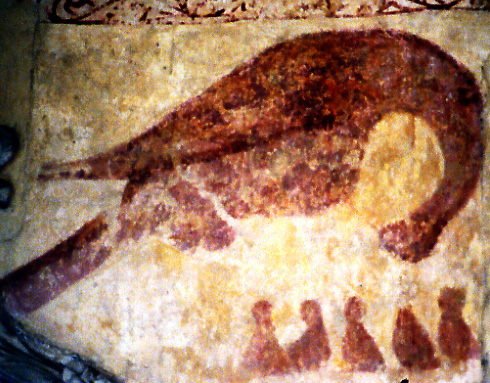Belchamp Walter, Essex (†Chelmsford) c.1350
The Pelican in its Piety
(speaking of the Apostle John) “This is the one who lay upon the breast
Of him our Pelican; and this is he
To the great office from the cross elected.”
[Dante, Paradiso, 25:112] trs HW Longfellow

The identification of Christ with the Pelican is very ancient, and long precedes Dante. Thomas Aquinas refers to it, as does the visionary saint Gertrude. There are various Biblical references to it and it has many aspects; the relevant one here being the belief that the pelican fed its young with blood pecked from its own breast Here at the left we see this in action. The parent pelican, facing right, with its short and blunt tail at the left, bends its head and neck, curving inward towards its own breast Unfortunately, the head and beak have faded into the background, making the painting very hard to interpret without some context.
Below the parent pelican’s head are its young, a row of five small pelicans awaiting sustenance. When the pelican is shown in this manner it is said to be ‘in its piety’.
The subject was popular in medieval woodwork, for bench-ends and the like, and its popularity persisted beyond the Middle Ages. Elizabeth 1 of England adopted it as a personal badge (she had the Phoenix as another). This is, however, the first example of it I have seen in a wall painting. But, as usual, there may once have been many others. It suggests a scholarly incumbent, as do many of the other paintings here, such as this one of the Virgin Mary.